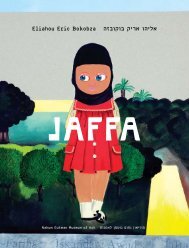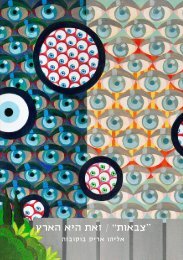How does Eliahou Eric Bokobza's naive style reflect on his ...
How does Eliahou Eric Bokobza's naive style reflect on his ...
How does Eliahou Eric Bokobza's naive style reflect on his ...
Create successful ePaper yourself
Turn your PDF publications into a flip-book with our unique Google optimized e-Paper software.
A Naïve Reflecti<strong>on</strong> <strong>on</strong> History:<br />
<str<strong>on</strong>g>How</str<strong>on</strong>g> <str<strong>on</strong>g>does</str<strong>on</strong>g> <str<strong>on</strong>g>Eliahou</str<strong>on</strong>g> <str<strong>on</strong>g>Eric</str<strong>on</strong>g> <str<strong>on</strong>g>Bokobza's</str<strong>on</strong>g> Naive<br />
Style Reflect <strong>on</strong> His Biographical History<br />
and Political Views?<br />
דר' מירב ירושלמי<br />
קורס בחירה לתואר שני: אמנות עכשווית- אז מה עכשיו?<br />
מגישה: יונינה האוזר –כפיר<br />
ת.ז: 244114110<br />
1
A Naïve Reflecti<strong>on</strong> <strong>on</strong> History: <str<strong>on</strong>g>How</str<strong>on</strong>g> <str<strong>on</strong>g>does</str<strong>on</strong>g> <str<strong>on</strong>g>Eliahou</str<strong>on</strong>g> <str<strong>on</strong>g>Eric</str<strong>on</strong>g> <str<strong>on</strong>g>Bokobza's</str<strong>on</strong>g> Naive<br />
Style Reflect <strong>on</strong> His Biographical History and Political Views?<br />
"The Naïve painting is very simple in its <str<strong>on</strong>g>style</str<strong>on</strong>g>, sometimes looks as<br />
child- like painting, with very bright and cheerful colors. Because it was made<br />
outside the traditi<strong>on</strong>al art <strong>his</strong>torical c<strong>on</strong>tinuum, it has a raw power and<br />
universal appeal. Like music, it speaks directly to the soul." 1 The Naïve artist<br />
creates a visual image of the world bringing together <strong>his</strong> memories and<br />
feelings into a wishful remembering of the past. Most Naïve artists are self<br />
taught, motivated by imaginati<strong>on</strong> "striving to embody the 'felt power' in things<br />
rather that their accurate portrayal." 2 T<strong>his</strong> appeal is brought <strong>on</strong> by the joyinspiring<br />
palette of colors used and the simple nostalgic feel- as if it used to be<br />
simple and fun. In order to understand and grasp t<strong>his</strong> <str<strong>on</strong>g>style</str<strong>on</strong>g> it must be<br />
separated from the Primitive art. Primitive art is more culturally defined and<br />
located in isolated areas.<br />
The term Naïve Painting sits well with the artist <str<strong>on</strong>g>Eliahou</str<strong>on</strong>g> <str<strong>on</strong>g>Eric</str<strong>on</strong>g> Bokobza,<br />
although he did learn art, he did so at an older age then most. After owning a<br />
pharmacy and not quite feeling inside <strong>his</strong> own skin, Bokobza decided to go to<br />
Kalisher and study art. There he developed <strong>his</strong> own sense of <str<strong>on</strong>g>style</str<strong>on</strong>g>, in which<br />
he associated himself "as a metaphorical descendent of the Mizrahi painters."<br />
He cultivates the c<strong>on</strong>flicts which are an inseparable part of <strong>his</strong> pers<strong>on</strong>ality.<br />
The c<strong>on</strong>flicts between the east and the west, short and tall, man and woman,<br />
dominating and dominated resides in <str<strong>on</strong>g>Bokobza's</str<strong>on</strong>g> mind and finds harm<strong>on</strong>y. 3<br />
When researching Bokobza the terms <str<strong>on</strong>g>naive</str<strong>on</strong>g>, childlike, and colorful<br />
appear. These words attempt to summarize <str<strong>on</strong>g>Bokobza's</str<strong>on</strong>g> <str<strong>on</strong>g>style</str<strong>on</strong>g> and frame of<br />
mind. In <strong>his</strong> works he relies up<strong>on</strong> <strong>his</strong> traditi<strong>on</strong>al background of being Mizrahi.<br />
1 http://engel-art.co.il/artists.php?act=show&id=1072<br />
2 Tuan, Yi- Fu, Realism and Fantasy in Art, History and Geography, 1990<br />
לורי, אביבה, אליהו בוקובזה סגר את בית המרקחת שלו בתל אביב ועכשיו הוא מצייר, עיתון הארץ 0242<br />
3<br />
2
T<strong>his</strong> is exhibited by the color scheme and symbolism used threw out <strong>his</strong><br />
works. In t<strong>his</strong> manner he emphasizes <strong>his</strong> feelings of the outsider, the different.<br />
His is quoted saying that he chose to become characterized in <strong>his</strong> authentic<br />
and outright Mizrahi <str<strong>on</strong>g>style</str<strong>on</strong>g> of painting. "The kind that is easy to label as<br />
misunderstood and primitive."<br />
In an attempt to understand <str<strong>on</strong>g>Bokobza's</str<strong>on</strong>g> work it is important to<br />
understand the c<strong>on</strong>cept. The Naïve type of work "has its source in a desire for<br />
pers<strong>on</strong>al expressi<strong>on</strong>… lacking in artistic suavity it may be, but it is a source of<br />
delight simply because its subject matter is plain… it is a <str<strong>on</strong>g>reflect</str<strong>on</strong>g>i<strong>on</strong>, direct and<br />
unhampered, of life as it is seen and felt [by the artist]". Bokobza works in<br />
such a way that he "seems to be painting in the spirit of a child." 4 The Folk<br />
art, or Mizrahi art in <strong>his</strong> case, uses the ethnic characteristics found in <strong>his</strong><br />
background- while growing up as a Sfardi in Israel. His paintings are full of<br />
luck symbols, and textile patterns.<br />
While focusing <strong>on</strong> <strong>his</strong> exhibiti<strong>on</strong> The Boy Who Drew Cats, 2008<br />
Bokobza relies <strong>on</strong> <strong>on</strong>e of <strong>his</strong> favorite fairy tale from <strong>his</strong> childhood that <strong>his</strong><br />
mother used to tell him. T<strong>his</strong> is the type of inspirati<strong>on</strong> Bokobza often turns to<br />
in <strong>his</strong> works. "He resurrects from the depths of memory an intimate and<br />
exciting moment." By doing so, Bokobza creates an interesting dialog<br />
between the child and the adult. Comparing the fairy tale to <str<strong>on</strong>g>Bokobza's</str<strong>on</strong>g> own<br />
childhood exhibits many similarities. In the Japanese fairy tale, written by<br />
Lafcadio Hearn, "the youngest s<strong>on</strong> in a family of farmers is sent to the temple<br />
to become a priest. <str<strong>on</strong>g>How</str<strong>on</strong>g>ever, instead, he has an unc<strong>on</strong>trollable urge to draw<br />
cats. Later <strong>on</strong> the boy finds a way to a temple that has been aband<strong>on</strong>ed after<br />
being taken over by an evil goblin in the shape of a rat. The boy begins to fill<br />
the space with drawings of cats. In the morning he discovers the dead body of<br />
the goblin rat <strong>on</strong> the floor of the temple, while all around the mouths of the<br />
many cats he drew were smeared red with blood." By using t<strong>his</strong> fairy tale<br />
Bokobza introduces <strong>his</strong> own childhood, of being an outsider and not fitting in<br />
4 Harper J. Russell, A People's Art, University of Tor<strong>on</strong>to Press<br />
3
at school. His goblin might have perhaps been <strong>his</strong> feelings of becoming<br />
"normal". His victory being <strong>his</strong> red over-cote <strong>his</strong> mother had him ware over <strong>his</strong><br />
uniform at the time, thus becoming a dominating color in many of <strong>his</strong> painting.<br />
T<strong>his</strong> cote gave him the feeling of being unique, different, an outsider looking<br />
in. "In the Japanese tale, as in <str<strong>on</strong>g>Bokobza's</str<strong>on</strong>g> pers<strong>on</strong>al <strong>his</strong>tory, cats symbolize the<br />
link to the inner self, to the authentic, instinctive essence deep within the<br />
artist's soul."<br />
It is in t<strong>his</strong> exhibiti<strong>on</strong> that Bokobza uses the Naïve to work threw <strong>his</strong><br />
fears and emoti<strong>on</strong>s <strong>on</strong> dealing with the missile attack <strong>on</strong> Israel at the time. He<br />
makes the c<strong>on</strong>necti<strong>on</strong> between the two nati<strong>on</strong>s across time, Japan and Israel.<br />
The color red appears in the Japanese flag as the red sun, and the name<br />
given to the warning of the missiles in Israel, red dawn. 5<br />
Taking a look at <strong>his</strong> trio of self portraits, Self portrait as a lucky cat (see<br />
index image #1); Bokobza portrays himself in a humoristic and comic manner.<br />
The three cats are drawn similar to carto<strong>on</strong> drawings "Chay" ,)חי) the Blue<br />
Eye- to warn off evil, and the Hand .(חמסה) By doing t<strong>his</strong> Bokobza "challenges<br />
the percepti<strong>on</strong> of cats as bearers of bad luck". 6<br />
“…the general good fortune and fertility granted to those who owned a cat,<br />
and above all the noti<strong>on</strong> that the cat can be an incarnati<strong>on</strong> of a spiritual<br />
being... In additi<strong>on</strong>, there are powerful associati<strong>on</strong>s with the cat and the<br />
afterlife in a n<strong>on</strong>- Christian sense. It is thought that the spiritual power of the<br />
cat was so great that they were able to resurrect the dead under certain<br />
circumstances... Cats are thought to have healing power… there are noti<strong>on</strong>s<br />
5 Interview with <str<strong>on</strong>g>Eliahou</str<strong>on</strong>g> <str<strong>on</strong>g>Eric</str<strong>on</strong>g> Bokobza, 17.9.2010<br />
6 Markovitch Dalia PHD, Al<strong>on</strong> Ktzia PHD, The boy who drew cats, Nelly Aman Gallery, Tel-<br />
Aviv, June 2008<br />
4
that cats can c<strong>on</strong>trol the weather and are the protectors of the sailors <strong>on</strong> the<br />
sea…” 7<br />
They also have a smile <strong>on</strong> their face- adding the similarity to the Cheshire cat<br />
from Alice in W<strong>on</strong>derland. T<strong>his</strong> cat being somewhat devilish, mysterious and<br />
quite mad.<br />
"Oh, you can't help that,' said the Cat: ' we're all mad here. I'm mad. You're<br />
mad.'…<br />
'And how do you know that you're mad?'<br />
'To begin with,' said the Cat, 'a dog's not mad. You grant that?'<br />
'I suppose so,' said Alice.<br />
'Well, then,' the Cat went <strong>on</strong>, 'you see, a dog growls when it's angry, and<br />
wags its tail when it's pleased. Now I growl when I'm pleased, and wag my tail<br />
when I'm angry. Therefore I'm mad.' " 8<br />
T<strong>his</strong> statement made by the Cheshire Cat resembles <str<strong>on</strong>g>Bokobza's</str<strong>on</strong>g> feeling of<br />
c<strong>on</strong>troversy. Bokobza states in <strong>on</strong>e of <strong>his</strong> interviews that he has never felt<br />
fully Israeli. In high school he made himself into the ultimate outsider, and was<br />
even quite accepted as the different <strong>on</strong>e. 9 In additi<strong>on</strong> the cats have the same<br />
characteristic that is most identified in <strong>his</strong> works- the big warm eyes, "that<br />
seem to look at the viewer without really looking at him." 10 They are wearing a<br />
goggle resembling <strong>on</strong>e of a pharmacist.<br />
7 D<strong>on</strong>ald W. Engles, Classical Cats: the rise and fall of the sacred cat, p.128<br />
8 Carrol, Lewis, Alice in W<strong>on</strong>derland, first published 1865, republished by Forgotten Books<br />
2008, p.48<br />
9 Gibs<strong>on</strong> Eetta-Prince, In Place, Across Time, The Jerusalem Report, 2007<br />
רותם רוזנטל ,מרב היימן ואריק בוקובזה מציגים: תפוזים ופוסט-ציונות, 0242, עכבר העיר אונליין<br />
10<br />
5
The other cats in t<strong>his</strong> exhibiti<strong>on</strong> bring <str<strong>on</strong>g>Bokobza's</str<strong>on</strong>g> take <strong>on</strong> political views.<br />
He relies <strong>on</strong> the assumpti<strong>on</strong> that the viewer must be somewhat familiar with<br />
the literary or cultural source to which it refers. 11 His painting, American Cat<br />
(see index image #2), shows a dark cat holding a bomb between <strong>his</strong> teeth.<br />
T<strong>his</strong> is an exact replica of the insignia of the original military unit. Bokobza<br />
makes the c<strong>on</strong>necti<strong>on</strong> between the carto<strong>on</strong>- look and childlike painting to the<br />
fact that the soldiers are in fact children themselves. The innocent cat holding<br />
a bomb serves as a mirror to the cruelty of war and killing. T<strong>his</strong> cat stands in<br />
c<strong>on</strong>trast to the rest in the exhibiti<strong>on</strong> with <strong>his</strong> devilish and manic expressi<strong>on</strong>.<br />
His mouth is not in a smile rather in a m<strong>on</strong>ster sharp teeth attach mode. His<br />
eyes, true to form, are big, wide and glaring at the spectator, however they<br />
are neither innocent nor <str<strong>on</strong>g>naive</str<strong>on</strong>g>. What makes t<strong>his</strong> painting c<strong>on</strong>form to<br />
<str<strong>on</strong>g>Bokobza's</str<strong>on</strong>g> Naive <str<strong>on</strong>g>style</str<strong>on</strong>g> is the basic color scheme and carto<strong>on</strong> drawing of it,<br />
resembling Oriental comics and carto<strong>on</strong>s.<br />
In a c<strong>on</strong>trary and yet corresp<strong>on</strong>ding manner, <str<strong>on</strong>g>Bokobza's</str<strong>on</strong>g> exhibiti<strong>on</strong><br />
Jaffa, presented in 2010 exhibited a series of drawings <strong>on</strong> cut out paper dolls.<br />
Bokobza glued American cart<strong>on</strong> cut out dolls from the 1940s and gave them<br />
various outfits and scene settings. He situates the girls in the first decades of<br />
the 20 th century, the beginning of the settlement of Israel, in the different<br />
streets in Jaffa, naming them the original street name. It is here that Bokobza<br />
defines a new past, creating ficti<strong>on</strong> al<strong>on</strong>gside a grain of truth and political<br />
criticism. 12<br />
The main figure, Alhambra (see image index #3) looks like an all<br />
American girl next door. She is dressed in her underwear, standing in a very<br />
innocent childlike manner. The scene around her is set in a Tzabari, Israeli<br />
orange field, with a building holding the name Alhambra. Bokobza uses a very<br />
11 DeSousa, Michael A., and Martin J. Medhurst. 1982. "Political Carto<strong>on</strong>s and American<br />
Culture:Significant Symbols of Campaign 1980." Studies in Visual Communicati<strong>on</strong> 8: 84-97.<br />
12 Dalia Markovirch and Ktzia Al<strong>on</strong>: Bezalel Versi<strong>on</strong> B, Artisrs house, Jerusalem, 2000<br />
6
asic color scheme of bright colors and sunny clear sky. The backdrop is<br />
based <strong>on</strong> Nahum Gutman's paintings.<br />
It is interesting to note that the meaning of the word Alhamra, in direct<br />
translati<strong>on</strong> from Arabic, is the red <strong>on</strong>e. In child folklore t<strong>his</strong> is interpreted as<br />
“little red riding hood”. It is in t<strong>his</strong> childhood fairytale that a young girl is set<br />
out al<strong>on</strong>e and is met with a wolf that plots to eat her. Both the girl in the<br />
fairytale and the girl in the painting appear naïve and innocent. When in fact<br />
there is a lot more to them and they merely seem innocent.<br />
Other girls in the series are situated al<strong>on</strong>e located <strong>on</strong> different streets<br />
exhibiting the various looks and religi<strong>on</strong>s that could have been seen at that<br />
time (see image index #4).<br />
In another exhibiti<strong>on</strong> Zi<strong>on</strong>'s ficti<strong>on</strong>, painting installati<strong>on</strong> in 3 parts, 2004<br />
Bokobza expresses a very complex and violent situati<strong>on</strong> through what looks<br />
to be a child's game. He combines fantasy, games and banishment of settlers<br />
into <strong>on</strong>e Naïve painting <strong>on</strong> a hologram paper. He manages to create<br />
something in between the tangible and the mad. 13 The painting, C<strong>on</strong>veyor 1<br />
shows a computer-looking figure with big eyes sitting <strong>on</strong> a tank carrying<br />
buildings; the painting, C<strong>on</strong>veyor 2 shows a similar looking figure carrying<br />
citrus trees (see image index numbers: 5,6). Bokobza keeps the color red<br />
very dominant in both of the paintings. His paintings exhibit the feeling that the<br />
politics are similar to children's computer games, <strong>his</strong> images <strong>on</strong>ly appearing to<br />
be innocent.<br />
Through researching <str<strong>on</strong>g>Bokobza's</str<strong>on</strong>g> paintings and works <strong>his</strong> Naïve <str<strong>on</strong>g>style</str<strong>on</strong>g><br />
takes <strong>on</strong> different meanings and understandings, as each layer of <strong>his</strong> work is<br />
unraveled. His pers<strong>on</strong>al <strong>his</strong>tory and childhood experiences take a more<br />
predominant place in the various paintings. He uses a tribute to other artists in<br />
order to give <strong>his</strong> work an underlining basis and then changes the story line<br />
and the <strong>his</strong>tory of the subject matter to fit <strong>his</strong> childhood memories. T<strong>his</strong><br />
מלצר, גלעד, אמת נאיבית, צבע, ידיעות אחרונות, 0221<br />
13<br />
7
emphasis's the problem with using the Naïve <str<strong>on</strong>g>style</str<strong>on</strong>g> as an <strong>his</strong>torical reference.<br />
The refecti<strong>on</strong> in the Naive <str<strong>on</strong>g>style</str<strong>on</strong>g> is <strong>on</strong>e of a child's point of view, or more<br />
precisely of a grown up's memory and belief as to how it should have been.<br />
Thus, creating a work that seems <strong>on</strong> the first glance as being superficial and<br />
plain which may lead in a misunderstanding of the underlining agenda. T<strong>his</strong> is<br />
the situati<strong>on</strong> in <str<strong>on</strong>g>Bokobza's</str<strong>on</strong>g> The Boy Who Drew Cats. His paintings of cats<br />
drew most of the attenti<strong>on</strong> to the cat and not to the hidden fear and the<br />
dealing with the attack <strong>on</strong> Israel that Bokobza was experiencing at the time.<br />
<str<strong>on</strong>g>How</str<strong>on</strong>g>ever, <strong>on</strong>ce understanding what the artist was trying to do, or at<br />
least understand where the artwork is coming from, the Naïve <str<strong>on</strong>g>style</str<strong>on</strong>g> gives an<br />
interesting insight into a unique and different remembrance of a childhood's<br />
<strong>his</strong>tory. In spite it's inaccuracies the Naïve <str<strong>on</strong>g>style</str<strong>on</strong>g> dem<strong>on</strong>strates how not <strong>on</strong>ly<br />
<str<strong>on</strong>g>does</str<strong>on</strong>g> popular culture and folklore <str<strong>on</strong>g>reflect</str<strong>on</strong>g> <strong>on</strong> our political culture, but the<br />
attenti<strong>on</strong> to the popular and folklore may in fact impact <strong>on</strong> our impressi<strong>on</strong>s to<br />
the political culture. 14<br />
14 C<strong>on</strong>ners L. Joan, "Popular Culture in Political Carto<strong>on</strong>s: Analyzing Carto<strong>on</strong>ist<br />
Approaches", Political Science & Politics 40 (2007): 261-265.<br />
8
Image index:<br />
#1:<br />
Self portrait as a lucky cat, 2008<br />
Ink & Acrylic <strong>on</strong> Cardboard, 25x20 cm<br />
#2<br />
American Cat, 2008<br />
Vintage WW2 Flight patch<br />
Ink & Acrylic <strong>on</strong> Cardboard. 25x20 cm.<br />
9
#3:<br />
Alhambra, 2009<br />
Acrylic paint, Japanese ink, collage of paper doll and dresses <strong>on</strong> cardboard,<br />
100x70 cm.<br />
#4:<br />
Afifah 3320 st 50x70cm<br />
Fariha Iskandar Awad st. 50x70 cm Yasmin Salama st. 50x70cm<br />
11
#5:<br />
C<strong>on</strong>veyor 1, 2004<br />
Acrylic paint <strong>on</strong> Hologram paper, 40x80 cm<br />
#6:<br />
C<strong>on</strong>veyor 2, 2004<br />
Acrylic paint <strong>on</strong> Hologram paper, 40x80 cm<br />
11
References:<br />
Anders<strong>on</strong>, Kent, and David Baker, The Spirit of Folk Art, School Arts,<br />
1993<br />
Aviv, Naomi, Zi<strong>on</strong>s Ficti<strong>on</strong>, Painting Instalati<strong>on</strong> in 3 Parts, <str<strong>on</strong>g>Eliahou</str<strong>on</strong>g> <str<strong>on</strong>g>Eric</str<strong>on</strong>g><br />
Bokobza: Herzl and the Refugees, Nelly Aman Gallery, 2003<br />
Carrol, Lewis, Alice in W<strong>on</strong>derland, first published 1865, republished by<br />
Forgotten Books 2008, p.48<br />
C<strong>on</strong>ners L. Joan, "Popular Culture in Political Carto<strong>on</strong>s: Analyzing<br />
Carto<strong>on</strong>ist Approaches", Political Science & Politics 40 (2007): 261-<br />
265.<br />
Danto, Arthur Coleman, Primitivism' in 20 th Century Art, The Nati<strong>on</strong>,<br />
1984<br />
DeSousa, Michael A., and Martin J. Medhurst. 1982. "Political Carto<strong>on</strong>s<br />
and American Culture:Significant Symbols of Campaign 1980." Studies<br />
in Visual Communicati<strong>on</strong> 8: 84-97.<br />
D<strong>on</strong>ald W. Engels , Classical cats: the rise and fall of the sacred cat,<br />
http://books.google.com/books?id=VkqtGl7VN44C&pg=PA109&dq=ro<br />
man+gods+and+cats&cd=1#v=<strong>on</strong>epage&q=roman%20gods%20and%<br />
20cats&f=false<br />
Eichenbaum, Pola, Naïve Art, 18 Israeli Artists, Tel Aviv Museum,<br />
Dizengoff House, 1970<br />
Gibs<strong>on</strong> Eetta-Prince, In Place, Across Time, The Jerusalem Report,<br />
2007<br />
Harper J. Russell, A People's Art, University of Tor<strong>on</strong>to Press<br />
Larkin, David, Innocent Art, Ballantine books NY, 1974<br />
Lint<strong>on</strong>, Ralph, Primitive Art, The Keny<strong>on</strong> Review, Vol. 3, Num. 1 1941,<br />
p. 34-51, Keny<strong>on</strong> College<br />
Markovitch Dalia PHD, Ktzia Al<strong>on</strong> PHD, The boy who drew cats, Nelly<br />
Aman Gallery, Tel- Aviv, June 2008<br />
Markovirch Dalia and Ktzia Al<strong>on</strong>: Bezalel Versi<strong>on</strong> B, Artisrs house,<br />
Jerusalem, 2000<br />
12
Oshima, Seiji, From the Collecti<strong>on</strong>: Naivety in Art, Setagaya Art<br />
Museum, 1996<br />
Reiss, Ifat, The Naïve World, GINA Gallery of Internati<strong>on</strong>al Naïve Art<br />
Ltd. 2006<br />
Seifert Lauren Sue, Real World Knowledge Facilitates Interpretati<strong>on</strong> of<br />
Paintings by Naïve Art Observers, The Journal of Psychology,1993<br />
Sheffi, Smadar, Bezalel's Sec<strong>on</strong>d Chance, the Jerusalem Report, 2007<br />
Stevens, Christine, The Death of Authentic Primitive Art and Other<br />
Tales of Progress, Folklore, 2000<br />
Tamir, Tali, Jaffa, On the Dialogue between <str<strong>on</strong>g>Eliahou</str<strong>on</strong>g> <str<strong>on</strong>g>Eric</str<strong>on</strong>g> Bokobza and<br />
Nahum Gutman, Nahum Gutman Museum of Art, 2010<br />
Yi-Fu Tuam, Realism and Fantasy in Art, History, and Geography,<br />
AAG, Vol. 80 No. 3 (Sep 1990) p. 435-446, Taylor & Francis, Ltd.<br />
בוקובזה אליהו אריק- "פלורה", 0222<br />
מלצר, גלעד, אמת נאיבית, ידיעות אחרונות, צבע, 0221<br />
לורי, אביבה, אליהו בוקובזה סגר את בית המרקחת שלו בתל אביב ועכשיו הוא<br />
מצייר,עיתון הארץ 0242<br />
רותם רוזנטל ,מרב היימן ואריק בוקובזה מציגים: תפוזים ופוסט-ציונות, 0242, עכבר<br />
העיר אונליין<br />
שרפשטיין, בן עמי, ספונטניות באמנות, הוצאת ספרים עם עובד, 0222<br />
<br />
<br />
<br />
<br />
<br />
<br />
<br />
<br />
<br />
http://books.google.com/books?id=D1wZuTutJbwC&printsec=fr<strong>on</strong>tcove<br />
r&dq=roman+gods+and+cats&source=gbs_similarbooks_s&cad=1#v=o<br />
nepage&q=roman%20gods%20and%20cats&f=false<br />
http://books.google.com/books?id=r0yWikfDI8IC&pg=PA61&dq=femini<br />
n+cats&lr=&as_brr=3&cd=1#v=<strong>on</strong>epage&q=&f=false<br />
http://engel-art.co.il/artists.php?act=show&id=1072<br />
http://larsdatter.com/cats.htm<br />
13






